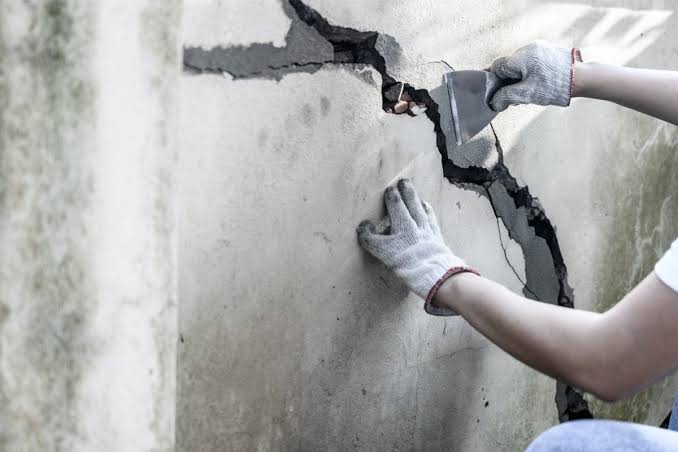A strong foundation is paramount for the longevity and safety of any structure. Over time, even the most solid foundations can develop cracks due to various factors like soil movement, extreme weather conditions, and the natural settling process of a building. Foundation crack repair, especially in basements, is a critical maintenance task that homeowners should pay attention to. Basement crack repair prevents water from seeping into the home and contributes to the structure’s overall stability.
Putting a blind eye on such issues can lead to more significant problems, potentially compromising the building’s integrity. Whenever this happens, you must invite a contactor to help with wet basement situation. This article aims to provide an in-depth look into the methods and techniques employed in fixing foundation and basement cracks, ensuring that the concrete remains intact and robust against the forces of nature.
Recognizing and Diagnosing Foundation Issues
Foundation cracks are often the first signs of potential structural issues. They can appear as thin hairline fractures, often caused by concrete shrinkage or thermal expansion and contraction. Alternatively, they might be more pronounced, signaling deeper structural problems. While not all cracks indicate immediate danger, distinguishing between aesthetic and structural cracks is crucial. Fixing basement cracks is not just about aesthetics; it is about preventing water ingress that can lead to mold, mildew, and deterioration of indoor air quality.
For foundation crack repair, identifying the underlying cause is the first step. This could be due to excessive load, improper construction, or environmental influences. Repair methods are determined based on size, accessibility, and whether the cracks are static or dynamic. Understanding these nuances is vital in choosing the appropriate repair technique to ensure the longevity of the repair.
Modern Repair Techniques for Lasting Solutions
Fixing foundation cracks requires precision and expertise. For minor or non-structural cracks, epoxy injections are a common solution. These seal the crack effectively and provide strength similar to that of concrete, hence fixing concrete cracks efficiently. For non-active cracks, meaning they do not continue to expand or contract, polyurethane injections are a flexible alternative that can accommodate slight movements and prevent leaks. When it comes to structural cracks, more intensive methods are required.
These may include underpinning the foundation with piers to address settlement issues or using carbon fiber strips and steel braces to fortify the area. These methods of concrete crack repair are designed to restore the foundation’s structural integrity. Contractors might also use hydraulic cement for wider cracks, which expands as it cures, creating a tight seal. Each method is chosen based on the crack’s characteristics and the overall condition of the foundation.
Exterior vs. Interior Basement Crack Repairs
Effective basement crack repair can be performed from the interior or the exterior. Interior methods often involve injecting a sealant directly into the cracks from the inside, which is less invasive and can be less expensive. This approach is ideal for hairline and minor cracks. On the other hand, exterior repairs can be more comprehensive, involving excavating around the foundation to the full depth of the footing. Once exposed, the cracks can be sealed with waterproof materials, and a protective membrane may be applied to the foundation’s exterior.
Additionally, a new drainage system might lead water away from the foundation, mitigating the risk of future cracking due to hydrostatic pressure. While exterior repairs are more labour-intensive and costly, they often address the root cause of the cracking and can provide a more permanent solution. The chosen method will depend on the crack’s severity, the causes, and the homeowner’s budget.
Maintaining a Crack-Free Foundation
Prevention is key in avoiding the recurrence of foundation and basement cracks. To prevent future damage, proper water management around the foundation is essential. This includes ensuring that gutters and downspouts function correctly and that the ground slopes away from the foundation to prevent water pooling. Regularly inspecting and fixing foundation cracks early on can circumvent the need for more extensive repairs. Homeowners should monitor the moisture levels in the soil around their home, as extreme variations can lead to ground shrinkage or swelling, which stresses the foundation.
On top of that, avoiding planting deep-rooted trees near the foundation and maintaining consistent soil moisture levels during dry periods can help. Adhering to these preventative measures significantly reduces the likelihood of dealing with substantial foundation crack repair in the future. Regular inspections by professionals can also catch potential issues early on, ensuring that minor repairs can be made before they become major concerns.
Final Remarks
The process of foundation crack repair is not a mere patchwork but an integral part of preserving the structural integrity of a building. Whether through interior or exterior approaches, fixing concrete cracks requires a thorough understanding of the problem, precise ution of repair techniques, and a commitment to ongoing maintenance. As we have explored, the methods for fixing basement cracks and foundation fissures range from simple sealant injections to more complex underpinning and reinforcement. However, the ultimate goal remains the same: to restore and maintain a solid foundation that stands the test of time.

